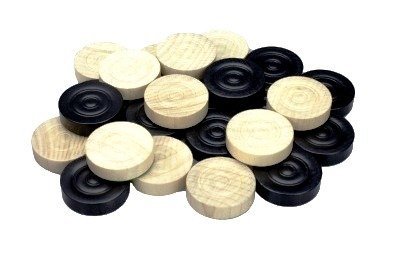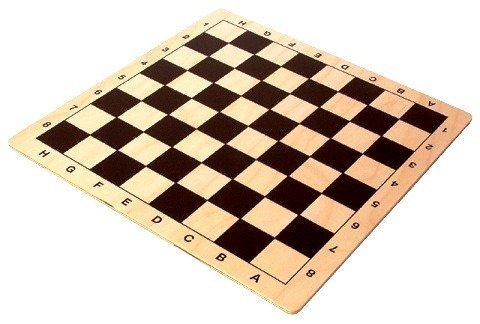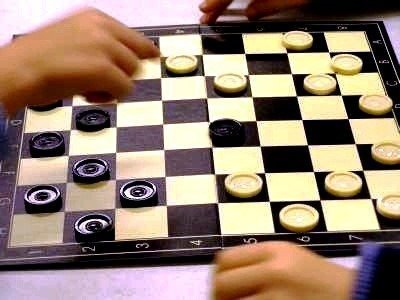Checkers game – two players can take part in this board game. A chess board is required, and the names of the fields with numbers and letters used in chess also apply to this game. You also need twelve black and twelve white game pieces, these are the same round pieces as for the well -known mill game . The rules are very easy and quick to learn.
Rules & Instructions
Checkers lost the rules of the game?
No problem, here you can download the checkers rules for free:
Download the instructions as a PDF for free
Data & facts
| Info | Daten |
|---|---|
| Spielalter: | ohne Altersangabe |
| Spieldauer: | ca. 20 Min. |
| Spieleranzahl: | 2 Spieler |
| Spielart: | Brettspiel |
| Ersterscheinung: | 10. oder 11. Jahrhundert |
| Spieleverlag: | unbekannt |
preparation
The chessboard should then be placed between the two players so that everyone in the first row on the left has a black corner square in front of them. Now everyone has to place their pieces on the black fields of the chess board in the first three rows facing them. There are four game pieces in each of these rows. The players try to move their pieces across the board in such a way that all of the opponent’s pieces are captured or made immobile. So it’s about taking away all of your opponent’s pieces or blocking them.
Goal of the game
The winner of the checkers game is the one who manages that his opponent cannot move any of his pieces. To achieve this goal, the pieces can be moved forward one move alternately: However, you can only move your pieces diagonally forward – So from one black field to the next black playing field in the corner. The white fields must not be played on, and backward movements are also not permitted (exception: “Queen” – see below). Accordingly, you can only hit your opponent’s stones diagonally. The hitting game piece must skip the one to be hit. So you have to be able to move the piece over the other to a free space.
Pieces hit in this way are removed from the game. If it is possible to capture an opponent’s stone from the target field after removing a stone, this can or must be done within the same move. This is possible as often as the opposing line-up and your own position allow. It is precisely these series of skipping that can lead to a quick victory. This is a great attraction for advanced users. It is particularly impressive when you penetrate through such a series, directly to the last row of the opponent and get a queen.
“Checkers” game
If a piece of your own side reaches a playing field on the opponent’s edge row, it counts as a “queen” from the next move on; it does not matter whether it arrives there simply moving forward or hitting. Subsequently, it is “doubled” with a second, eliminated stone (usually the opposing playing color) in order to clearly mark the game stone as a queen. The special thing about the “lady” is that she is allowed to move forwards and backwards and that as far as she likes in the chosen diagonal direction.
This means that from her location she rules over two crossing diagonals, so to speak, and therefore has to capture every piece that is on a playing field in these diagonals; of course, provided that at least one playing field behind him is free from the queen’s point of view. However, after the move with which she captured a stone, the lady does not have to place herself behind the field of the stone in question, but can still move freely. Provided there are still more free playing fields in this diagonal. Pieces of your own party may not be skipped with the queen.
Important additional rules
If you touch a piece, you must – as in the game of chess – make a move with it – unless you explicitly announce beforehand that you want to adjust the piece.
If it is possible to hit a queen or a stone or several in a row, this must be used. If someone does not do this, then the opponent can simply take the corresponding piece off the board. This is called “blowing”. However, blowing is not considered a move, it must be hit accordingly even if the hitting piece puts it in a dangerous position on the playing field.
However, the right to blow does not have to be exercised. The player in question can also ask the opposing party to reset the wrong move and instead make the correct one. If at the end of the game one of the opponents has three queens and the other one who is on the diagonal a1 to h8, the game is canceled as a “draw”. Besides the owner of the three queens is able to beat the single queen on the next move.
Tip: You should be particularly careful towards the end of a game when you place your pieces on the edge of the game board. There you can move them less easily than in the middle of the field and so fall into a trap for the opponent more easily.
background
As early as the 17th century there were proven rules for the game of checkers; it is even mentioned in “Don Quixote” by Cervantes: The author quotes the old Spanish romance of Don Gaiferos, who forgets his own lady of the heart while playing checkers. It is also assumed that the game has been widespread in Europe since the 12th century, so it is assumed that it emerged from a much older game – Alquerque – because roots go back to ancient Egypt; However, written evidence did not exist until the 17th century.

More variants and game rules
German lady
With this variant, each player receives 16 (white or black) game pieces to place them on the 2 x 8 black and white fields of the first and second row.
Now applies in addition to or in deviation from the standard rules of the checkers game. Again, the pieces may not be moved backwards, but you may move them straight ahead and sideways, of course also diagonally. This means that, for example, a piece placed on b2 may be moved to a3, a4, b4, c4, d4 and d3. As with the basic rules, you have to skip the opposing piece when you capture, also without moving backwards. A queen can be moved forwards and backwards as desired, but only according to the same system of the other pieces. This means that the German queen is not allowed to leave several playing fields behind in one move
Here, too, you have to hit if you have the opportunity to do so, although your own pieces may not be skipped over. If a player has several options (e.g. both with the queen and with simple pieces) to remove opposing pieces from the field, he can choose any one. You don’t have to choose the draw with the queen
Polish lady
The “Polish lady” is also called the “French lady”. In principle, the rules are the same as for normal checkers.
However, there is the following variation in this game:
You may only move your normal pieces forwards (diagonally) as usual on moves that you cannot use to capture a piece. However, if you can capture, you can move all pieces – not just the queen – both forwards and backwards.
Impact lady (wrong lady)
In this variant, the basic rules for checkers apply. The aim, however, is to behave towards the opponent in such a way that you play “into his hand”, so to speak. This means that you place your pieces so that they can be beaten by the opponent. The winner is the one who is the first to run out of pieces on the board – hence the name: “Wrong Queen”.
war
For this variant you need 12 black and white game pieces. These are placed on the black squares in the first three rows of the game, following the basic rules of the “checkers”. The special thing here is that you can only move your pieces and not hit. In addition, the stones may only be moved forward (diagonally) onto the black fields.
It is now a matter of enclosing one or more of the opponent’s pieces in this way. “To wall in”, so to speak, so that the opponent can no longer make a move with them. A “walled-in” stone may only be removed from the board if it no longer has any connections to other stones of its color. That means when there are lots of stones from the opponent placed all around and, for example, only the edge of the playing field offers him back cover. However, if an enclosed and immobile token is still adjacent to a stone of its own color on at least one side, then it is not yet “dead”. The winner is the one who first walled in all of the opponent’s stones or removed them from the field.
Wolf and sheep
This checkers variant is played on the black fields of the game board, whereby two players can participate, as with all other variants. One of the players is the “wolf” and receives a black token, while the other receives the sheep. That’s four white stones.
The sheep are placed on the four black playing fields in the first row in front of the “sheep player”. The wolf may be placed on any black space – between the first and third row – in front of the “wolf player”.
The wolf is now allowed to move both forwards and backwards across the playing field, while the sheep are only allowed to move forwards. For both, however, the diagonal direction of pull applies. Both playing parties may only move one space further when it is their turn. Jumps over a piece are not allowed.
The first move is made by a sheep. The goal of the sheep is to lock the wolf in such a way that it can no longer move. It is therefore best for the sheep to work together – in a row – in order to “wall in” the wolf. However, if the wolf manages to break the chain / line of sheep, then he has won. The sheep are then no longer able to follow him because they are not allowed to move backwards.
Note lady rules:
This checkers game variant is particularly suitable for children as a preliminary stage for more difficult types of board games, as the possible combinations are limited and manageable.


